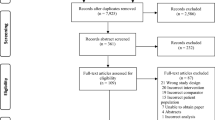Summary
A cumulative dose response to intravenous PGE1 was established in 12 healthy volunteers. Systolic time intervals, including pre-ejection period (PEP), the ventricular ejection time (VET) and the RR-interval, were continuously determined, and transcutaneous oxygen pressure (tcpO2) was recorded.
RR-intervals fell in a dose dependent manner, reaching a significantly lower level at 128 ng·kg−1·min−1 of PGE1 (basal value 842 ms falling to 756 ms). PEP decreased from 89 ms to 74 ms and the ratio PEP/VET decreased from 35% to 30%, indicating increased myocardial contractility. The maximal increase in tcpO2 was 125% on the calf and 60% on the foot. The peak tcpO2 was observed at an infusion rate of 16 ng·kg−1·min−1 PGE1. A decline in tcpO2 was seen at infusion rates >64 ng·kg−1·min−1 PGE1, indicating a decrease in skin perfusion.
The results indicate that the effects of intravenous PGE1 on skin perfusion occur at a lower threshold than the increase in myocardial contractility. A maximal increase in skin perfusion can be achieved with doses of PGE1 devoid of systemic haemodynamic effects.
Similar content being viewed by others
References
Adaikan PG, Tai NY, Lau LC, Karim SM, Kottegoda SR (1984) A comparison of some pharmacological actions of prostaglandin E1, 6-oxo-PGE1 and PGI2. Prostaglandins 27: 505–516
Arnaudov K, Faust U (1985) A microprocessor based system for long-term registration of the impedancecardiogram and the systolic time intervals. Med Prog Technol 10: 229–238
Bergström S, Duner H, Euler US, Pernow, Sjövall J (1959) Observations on the effects of infusion of prostaglandin E in man. Acta Physiol Scand 64: 145
Boudoulas H, Schaa SF, Lewis RP, Welch TG, Degreen P, Kates RE (1977) Negative inotropic effects of lidocaine in patients with coronary arterial disease and normal subjects. Chest 71: 170–174
Brecht T, Ayaz M (1985) Circulation parameters during intravenous and intraarterial administration of increasing doses of prostaglandin E1 in healthy subjects. Klin Wochenschr 63: 1201–1204
Carlson LA, Ekelund LG, Orö L (1969) Circulatory and respiratory effects of different doses of prostaglandin E1 in man. Acta Physiol Scand 75: 161–169
Carlson LA, Erikson I (1973) Femoral artery infusion of prostaglandin E1 in severe peripheral vascular disease. Lancet 20: 155
Carlson LA, Olsson AG (1976) Intravenous prostaglandin E1 in severe peripheral vascular disease. Lancet 2: 810
Creutzig A, Caspary L, Alexander K (1986) Prospective open pilot study to investigate the effect of intermittent arterial infusion treatment with prostaglandin E1 in patients with intermitent claudication. In: Sinziger H, Rogatti W (eds) Prostaglandins in atherosclerosis. Springer, Berlin Heidelberg
Creutzig A, Caspary L, Ranke C, Kießling D, Wilkens JH, Frölich JC, Alexander K (1987) Transkutaner pO2 und Laser Doppler Flux bei steigenden Dosierungen von intraarteriell und intravenös appliziertem Prostaglandin E1. Vasa 16: (in press)
Ewald U, Rooth G, Tuvemo T (1981) Postischemic hyperemia studied with a transcutaneous oxygen electrode at 33–37°C. Scand J Clin Lab Invest 41: 641
Fagrell B, Lundberg G, Olsson A, Ostergren J (1986) PGE1 treatment of severe skin ischemia in patients with peripheral arterial insufficiency — the effect on skin microcirculation. Vasa 15: 56–60
Harris WS, Schoenfeld CD, Weissler AM (1967) Effects of adrenergic receptor activation and blockade on the systolic preejection period, heart rate and arterial pressure in man. J Clin Invest 56: 1704–1714
Harris WS (1974) Systolic time intervals in the non-invasive assessment of left ventricular performance in man. In: Mirsky I, Ghista DN, Sandler H (eds) Cardiac mechanics. Wiley, New York, p 233
Heidrich H, Lammersen T (1985) Vitalkapillarmikroskopische Untersuchungen und transkutane pO2-Messungen bei intravenöser Prostaglandin E1 Infusion. Dtsch Med Wochenschr 110: 1283–1285
Hirai H, Nanki M, Ryu N (1985) Hemodynamic effects of intravenous PGE1 on patients with arterial occlusive disease of the leg. Angiology 36: 407–413
McGiff JC (1969) Selective passage of prostaglandins across the lung. Nature 223: 742–745
Mohapatra SN (1981) Non-invasive cardiovascular monitoring by electrical impedance technique. Pitman Medical, London
Nakano J, McCurdy JR (1967) Cardiovascular effects of PGE1. J Pharmacol Exp Ther 156: 538–547
Nowak J, Wennmalm A (1978) Influence of indomethacin and of prostaglandin E1 on total and regional blood flow in man. Acta Physiol Scand 102: 484–491
Olsson AG, Carlson LA (1976) Clinical, hemodynamic and metabolic effects of intraarterial infusions of prostaglandin E1 in patients with peripheral vascular disease. Adv Prost Thromb Res 1: 429–432
Reitan JA, Smith NT, Borison VS, Kadis LB (1972) The cardiac pre-ejection period: A correlate of peak ascending blood flow acceleration. Anesthesiology 36: 76
Rhodes RS, Heard SE (1983) Detrimental effect of high dose prostaglandin E1 in the treatment of ischemic ulcers. Surgery 93: 839–842
Rousson D, Galleyrand J, Sillie M, Boissel JP (1987) Uncorrected pre-ejection period: A simple non-invasive measurement for pharmacodynamic screening of inotropic activity. Eur J Clin Pharmacol 31: 559–562
Sachs L (1983) Angewandte Statistik. Springer, Berlin Heidelberg
Sakaguchi A, Kusaba A, Mishima Y, Kamiya K, Nishimura A, Furukuwa K, Shionoya S, Kawashima M, Katsumura T, Sakuma A (1978) A multiclinical double-blind study with PGE1 (alpha cyclodextrin clathrate) in patients with ischemic ulcer of the extremities. Vasa 7: 263–266
Talley RC, Meyer JF, MacNay JL (1971) Evaluation of the preejection period as an estimate of myocardial contractility in dogs. Am J Cardiol 27: 384
Author information
Authors and Affiliations
Rights and permissions
About this article
Cite this article
Wilkens, J.H., Wilkens, H., Elger, B. et al. Cardiac and microcirculatory effects of different doses of prostaglandin E1 in man. Eur J Clin Pharmacol 33, 133–137 (1987). https://doi.org/10.1007/BF00544556
Received:
Accepted:
Issue Date:
DOI: https://doi.org/10.1007/BF00544556




